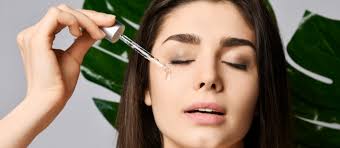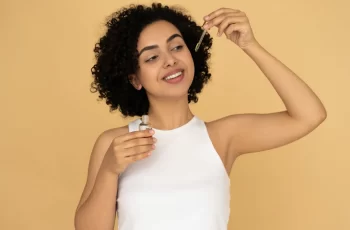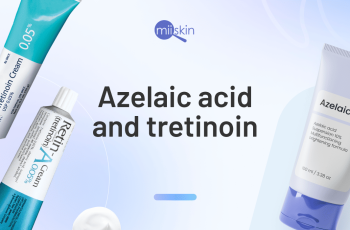
Can You Use Retinol with Ferulic Acid?
There are a few skincare mixing lessons amongst our blog posts, and today is another to add to the collection. Before we get started, I wanted to say that even the most experienced skincare fan can often become muddled with the ever-expanding selection of ingredients, especially if they have impossible names to pronounce.
It isn’t just the names throwing us off a little, you’ll find that with modern day technology, skincare formulations are more advanced than ever before. This results in consideration having to be taken when layering ingredients. It’s no longer a case of applying thinnest to thickest consistency, but to also focus on the actives themselves and how they can be work together. So, hold fire before you slather your skin with the latest trending “it” ingredient, as it may not play ball with your existing routine, even if you apply it in the correct order. Don’t worry for a second longer, as this is something we will be covering in today’s blog, so stick around to find out more about using retinol with ferulic acid.
This next section is going to be a brief recap of how these ingredients work on the skin and the benefits they deliver. If this is something you are feeling quite confident about, you can skip to the next part.
What is ferulic acid?
Ferulic acid is an antioxidant found mainly in anti-ageing skincare products as well as supplements and naturally occurring in certain foods such as oats, rice, eggplant, and bran. Not only does ferulic acid work at warding off damage caused from exposure to free radicals, such as UV light, central heating, and pollution, but it also contains an effective ability to boost how effective other antioxidants work on the skin, such as vitamins A, E and C.
It is considered a highly effective powerhouse skincare duo to combine ferulic acid and vitamin C together. This is because ferulic acid is able stabilise vitamin C whilst increasing its ability to minimise sun damage by boosting its photoprotection.
You’ll find the main benefits of ferulic acid is its antioxidants properties protecting the skin from free radicals, repairing the skin surface from existing damage, reversing signs of ageing by reducing the appearance of fine lines and wrinkles. All this and generally improving the overall health and glow of the complexion.
There’s a little more information about ferulic acid over on the Skin School, so do take a look to find out more.
What is retinol?
We’ve all heard the word retinol before, it is either already well and truly established step in your skincare routine, or it’s an ingredient you’ve avoided like the plague, as even the name feels too intimidating.
Retinol is a form of vitamin A and is crowned one of the most potent skincare ingredients. It’s naturally occurring in the skin which production begins to decrease over the age of 25. This potent powerhouse works at promoting the renewal of skin cells and boosting collagen production giving the skin a firmer, lifted, more youthful bounce. As well as targeting signs of ageing, you’ll find retinol also works at combating existing skin damage caused from sun exposure.
As effective as retinol is at improving the skin, it is a highly potent ingredient that if used incorrectly can cause a few side effects. It is very important to introduce retinol into your routine slowly to avoid an increase of redness, itching, irritation, and discomfort. Find out more about retinol and how it works on the skin by checking out our blog post.
Now that you’ve had a refresher of these two ingredients, let’s find out more about using them together.
Can I use retinol with ferulic acid?
Yes, you can, in fact using these ingredients together result in an incredible combination. When layered together, retinol and ferulic acid boost each other’s effectiveness on the skin. With retinol working at evening the skin tone and increasing firmness, ferulic acid helps retinol reach further into the deeper layers of the skin and promote collagen production. With both powerhouse ingredients tag teaming each other, you are left with a luminous, healthy, even complexion.
What can be used with ferulic acid?
The main benefit of ferulic acid, is the fact that it can work effectively teamed with other ingredients but can boost them making them even more powerful. Finding product formulas containing other antioxidant ingredients, such as vitamin C, and vitamin E.
As effective ferulic acid is at being combined with other ingredients, it is important to bear in mind that introducing a new skincare ingredient should occur once you have consulted with a doctor or dermatologist. This will ensure you are using the best ingredient for you and your skincare needs.
What acid goes well with retinol?
Teaming acids, such as hyaluronic acid promotes a balanced complexion enabling retinol to work on the skin without causing it to become dry and irritated. This is thanks to the humectant traits of hyaluronic acid and its ability to draw moisture into the skin and locking it into place.
As for other more potent ingredients such as glycolic acid, salicylic acid, and lactic acid, these should be applied when you are not using retinol. This is because the exfoliation these acids provide teamed with the increased stimulation of skin cell turnover can become too much for the skin. This will lead to an imbalance in pH levels in the skin as well as stripping the skin of oil resulting in irritation, redness, flaking, and general discomfort.
Can I use retinol every night?
Yes, you can in the end, but only after you’ve built the skin’s tolerance. The potency and formulation of the product also plays an important role in how often you can use retinol.
To begin with, it is best to apply retinol once or twice a week during your evening routine. After some time, many find they can use it every evening, this is very much dependant on your skin type and product. Ideally, it is best to use retinol every other night, this ensures it delivers results without causing any unwanted side effects.
There you have a little more information about these potent ingredients, and how to use retinol with ferulic acid. If you have any further questions don’t hesitate to come and find us on Instagram.


